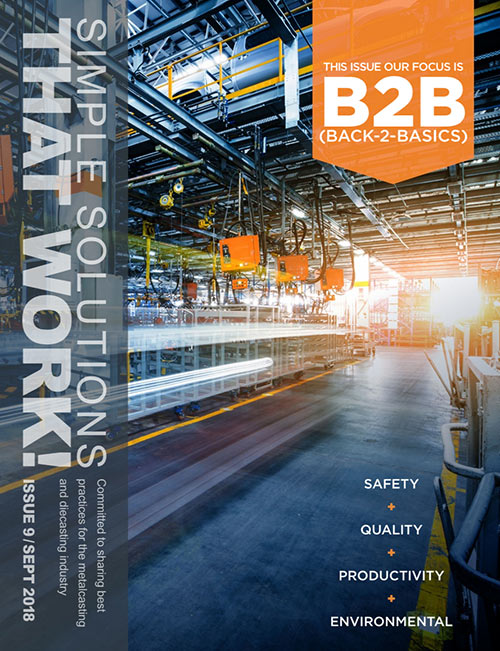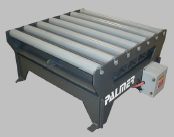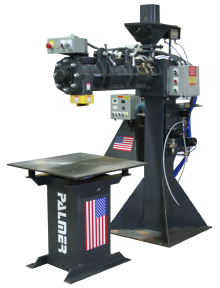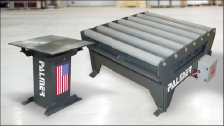Foundry & industrial processing Machinery EQUIPMENT & SYSTEMS
U.S. & Canada Call 1.800.457.5456
Importance of Compaction
Home Articles Importance of Compaction

Simple Solutions That Work!™, Volume 9, September 2018
Written - Jack Palmer.
Jack Palmer
President
Palmer Manufacturing & Supply, Inc.
Article Takeaways:
To properly compact a mold only takes 15–20 seconds, but the return on this short amount of time may be one of the highest among all foundry processes. From this short amount of time, a better casting with reduced cleaning requirements will be achieved.

Proper compaction results in:
- Better Surface Finish
As the sand grains are as close to one another as possible, this keeps metal from getting between the grains which results in a better surface finish. - Greater Mold Strength
Less binder is often required because the grains are as close together as possible. This means that a well compacted mold will be stronger than a poorly compacted mold at the same resin level. If a poorly compacted mold provides sufficient strength, then a well compacted mold with the same strength can be achieved with less resin addition, allowing for a reduction in resin costs. - Faster Shakeout and More Effective Reclamation
Shakeout is faster due to reduced resin levels, which also reduces binder costs. The LOI reduction through the reclamation system will also be improved based on the reduced resin level input. - Reduced Casting Defects
Defects are reduced because less binder is needed. Gasses are created when molten metal contacts the binder and must be properly vented out of the mold in order to prevent gas related casting defects. Reduced binder levels obviously result in less gas to be vented.
There is an old adage in the foundry that says “ vent , vent, and then vent some more” – while this is true in order to make a quality casting , it takes time and labor to not only make these vents, but to remove vents that are filled with metal such as risers but also to simply drill the vents. Vents that are set up as loose pieces on the pattern must be removed and returned to the box when it gets back to the molding station, maintained, and kept with the mold box when it is returned to storage and then back to molding.
- Reduced Casting Cleaning
Compaction reduces the time to clean your castings.
After casting quality, reduced casting cleaning is the second more important reason to properly compact your molds. With today’s labor market, it is very difficult to staff a cleaning room. With more jobs than workers in the US, workers are selecting jobs with the highest pay, and best working environment. With all of these options, working in a cleaning room will not be high on the list. For this reason, many foundries are spending large amounts of capital on automated casting grinding machinery.
The cleaning room is also a source for a large percentage of silica dust. Foundries typically perform silica mapping and testing procedures very near the shakeout / reclamation equipment.
In today’s international market, every foundry could be competing with others around the world. Quality requirements never become lesser - it is something of an intangible, but today’s casting buyers do not want parts that have been ground more than necessary. Some buyers are requiring zero parting line grinding. Some buyers simply will not accept castings that are ground all over to make up for poor foundry practices, nor will they accept parts that require machining fixtures that require adjustable stops simply because the foundry has poor molding process control.
It is critical to have the right equipment to properly compact and to follow procedures that are consistent and repeatable. While rotary vibrators are comparatively inexpensive and the accepted norm until recently, there is a much better alternative.
Electromagnetic Vertical Vibrators
Rotary vibrators simply cannot provide true vertical vibration, even when there are multiple vibrators counter rotating. Vertical Vibrator(s) can be turned down to a low level to compact a small mold or core, and turned right back up to compact larger work. It is critical to closely match the force output to the weight of the total of the tooling and sand.
High frequency vibration is important to the no-bake process. Vertical vibrators can be turned up or down without sacrificing frequency. Many times a rotary compaction table will be set up with a system to raise and lower the speed of the vibrators in an attempt to raise or lower the force. While the force does change, so does the frequency; with differencing frequencies for different weights of work coming across the compaction table, it is almost impossible to achieve any consistency with rotary vibrators.
Immediate Stop – rotary vs vertical vibrators
Rotary vibrators are difficult to stop immediately. However, that is exactly what’s needed to properly compact the mold. The vibrators must stop immediately in order to keep from imparting more force into the mold and over-compacting. Rotary vibrators attempt to achieve this number of ways, although none of which could be called stopping immediately and results in “loping.” This essentially turns the compaction table into a jolt table which can quickly defeat the whole compaction process, whereas vertical vibrators stop as soon as power is removed.
Over-compaction

It is possible to over-compact as well as under-compact your molds. A poorly compacted mold can result in burn in/on, increased demand for resin levels, poor surface finish, and increased cleaning room time as discussed above.
An over-compacted mold or core can result in a part with lines of weakness or fault lines that might not show up when handled, but could result in a mold failure when metal is introduced into the mold potentially resulting in runouts. As we all know, run-outs are inconvenient and expensive at the least and very dangerous at the most.
Drop & Stop
In order to select the proper force setting, it is common to run a “drop and stop” test. This is a test where the selected box is filled normally and then struck-off before compaction. The compaction cycle is started with the vibration time set at 5-10 seconds.
The sand surface is monitored as it compacts:
- If the sand is still going down when the vibrators stop, more force or duration of vibration is needed.
- If the sand drops and stops before the vibrators stop, less force or duration is needed.
If this test is performed on every job that comes in, the proper effective compaction settings can be determined quickly. It is not as simple as picking a force/ time setting based on weight, as deep work behaves differently than shallow wide work. In order to keep the compaction process simple and repeatable, it is recommended to keep the duration of vibration the same for all jobs. We normally recommend a setting of 5 seconds. It is critical that the operator is not in control of either the force setting or the duration of vibration. The operator can certainly turn the force output dial to the correct setting as determined by the technical manager, but that setting should not be under the operator’s control.
Force Setting Documentation
Documenting the force setting is as simple as writing the force output setting on the box. The compaction table dial is labeled as 0-100%. The tech simply performs the drop and stop test and writes the number on the side of the box. The operator runs the correct amount of sand into the box, turns the dial to the correct setting and presses the “cycle start “ button. At this point, the airbags inflate lifting the box off the rollers or support structure. Once the box is lifted, the vibrators run at the selected force output for the predetermined amount of time. Once this time runs out, the airbags are deflated, lowering the box back onto the conveyor rollers and, completing the cycle. This typically is a 15-20 second process. Then the top of the mold is the struck-off, moved to the next station, and the next job is moved into place.
When to Compact
In order to achieve consistency and repeatability, it is important to take as many of the decisions as possible away from the operator. We have already said that the force output and the duration of vibration is already predetermined.
The other two decisions are:
- when to initiate the compaction process
- amount of sand to put in the mold
If one operator starts the compaction process when the box is half full and the next operator starts it when the box is completely full, the results will be variable. The simple thing to do is to fill the box and then compact, while this is simpler, sometimes it is desirable to do this differently. For instance, a shallow job with a lot of surface area could generate a higher amount of gas and usually venting should take care of this. However, if the configuration of the mold is such that mechanical venting isn’t practical, it is common to cover the pattern, compact, and then fill out the rest of the box without compaction. This gives a good mold / metal interface with a permeable zone close to it thereby allowing gasses to escape through the mold itself.
Obviously, start time is another variable that needs to be controlled. It is a simple matter to tie the mixer run time into the compaction sequence where the compaction sequence is initiated after a certain amount of mixer run time. The mixer run time for a given mold should also be controlled by the technical manager, not the operator. Strike-off sand isn’t sand—its money. The less strike-off sand that is generated, the lower the mold cost.
The bottom line is this, there are few processes in the foundry that require only 15-20 seconds that can do as much as compaction can do for your castings – it’s just that simple.
Copyright © 2025 Palmer Manufacturing & Supply, Inc. | Terms and Conditions | Privacy Policy





